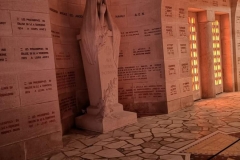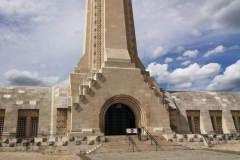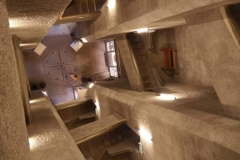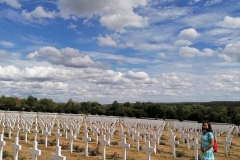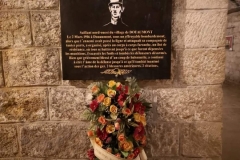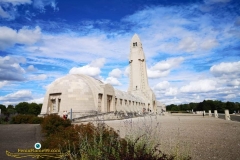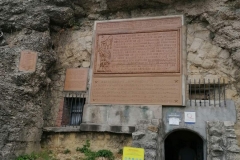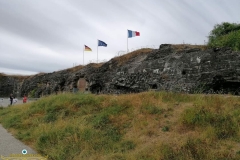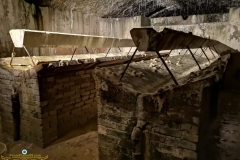19-08-2020 We were excited because we are going to visit the memorial of the soldiers that died during the First World War located in Verdun, France. We were being chauffeured by Gilles, Bella and Antoine to Ossuarium van Douaumont for the first stop. We were being pampered by Bella by preparing us the snacks for our lunch during the visits. We were grateful for her kindness.
Ossuarium van Douaumont
History :
“During the 300 days of the Battle of Verdun (21 February 1916 – 19 December 1916) approximately 230,000 men died out of a total of 700,000 casualties. The battle became known in German as Die Hölle von Verdun (English: The Hell of Verdun), or in French as L’Enfer de Verdun, and was conducted on a battlefield.”
As we strolled along the graveyard, we noticed that there are Muslim soldiers of the French Colonial Forces, whose remains were placed to rest in the Muslim section. Their graves are facing Mecca.
There is a memorial mosque erected on the eastern edge of the necropolis.
There is also a memorial wall, honoring the memory of Jewish soldiers, was unveiled in the western section of the cemetery in 1938.
It is a monument that contains the remains of 130,000 unidentified French and German soldiers. Where the skeletal remains of soldiers who died on the battlefield during the Battle of Verdun in WWI. It was built on the initiative of Charles Ginisty, Bishop of Verdun. It has been designated a “nécropole nationale”. Inside the building there are stained glass windows which was in the colored of red means blood of the soldiers died during the war. There is also a chapel together with a museum.
Through small outside windows, the skeletal remains of at least 130,000 unidentified combatants of both nations can be seen filling up alcoves at the lower edge of the building. On the inside of the ossuary building, the ceiling and walls are partly covered by plaques bearing names of French soldiers who died during the Battle of Verdun.
The tower contains a bronze death-bell, weighing over 2 tonnes called Bourdon de la Victoire, which is sounded at official ceremonies. It was offered by an American benefactor, Anne Thornburn Van Buren, in 1927. At the top of the tower is a rotating red and white “lantern of the dead”, which shines on the battlefields at night.
Oh yes, do not forget to visit the trenches and bomb craters opposite of the memorial. You may noticed a lot of slopes like the Teletubbies home. (small laughter, imagination) There were bomb craters formed due to the explosion from the bombing.
Tips : There is a tour guide provided during the visitation in the monument, you may choose English or French speaking (if only you truly understand French). Please remember to bring water bottle with you because you may get thirsty after climbing the stairs to the tower. There are 204 of steps to climb to the top of the tower. Good Luck!
Fort of Douaumont
Fort de Douaumont was the largest and highest fort on the ring of 19 large defensive works which had protected the city of Verdun, France since the 1890s. By 1915, the French General Staff had concluded that even the best-protected forts of Verdun could not resist bombardments from the German 420 mm (16.5 in) Gamma Guns.
Construction work started in 1885 near the village of Douaumont, on some of the highest ground in the area and the fort was continually reinforced until 1913.
These improvements had been completed by 1903. The entrance to the fort was at the rear. Two main tunnels ran east–west, one above the other, with barrack rooms and corridors to outlying parts of the fort branched off of the main tunnels.
The fort was equipped with numerous armed posts, a 155 mm rotating/retractable gun turret, a 75 mm gun rotating/retractable gun turret, four other 75 mm guns in flanking “Bourges Casemates” that swept the intervals and several machine-gun turrets. Entry into the moat around the fort was interdicted by Hotchkiss anti-personnel revolving cannons located in wall casemates or “Coffres” present at each corner.
Our experiences visiting the fort, we noticed there were a lot of visible cables along the wall. We were been told that the wall bricks were made from the limestones, that is why there were some mini stalactites.
Extra information : Stalactites form is a downward-tapering cone and is simply a thickening of the straw type by mineral deposition from a film of water descending the exterior of the pendant.
Fort Douaumont is the mightiest of the forts surrounding Verdun. Captured in a surprise attack four days after the beginning of the Battle of Verdun, it was occupied by the German Army for eight months. They used it as shelter for their troops and as essential back-up for their ongoing offensive. Despite several attempts at retaking the fort, it was not recaptured until 24 October 1916.
Therefore, you may notice there were a facility such as the bathroom with the simplest basin and the water tank, open public toilet for shit, double Decker queen size beds, a kitchen and a few classrooms. There were also a few tombstones.
Do not forget to climb on top of the fort too, can you imagine the soldier sitting inside armed post during the hot sun. As it was built with iron ore, I am sure the soldier suffered with heat strokes.
We encountered the most unforgettable moment at the time of 19.00, my co-director Bunny saw the image of a soldier running towards him. Mmm quite spooky. For those whom love paranormal activities, will be the perfect place. Make sure, ask permission first from the authorities before proceeding.
For those whom loves the history in the World War, this is the perfect place to visit. We also covered D-Day beaches. We will post that in another time. See you. Enjoy.
Index link for references :
https://en.wikipedia.org/wiki/Douaumont_Ossuary
https://en.wikipedia.org/wiki/Fort_Douaumont
